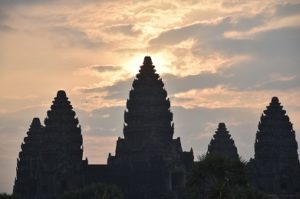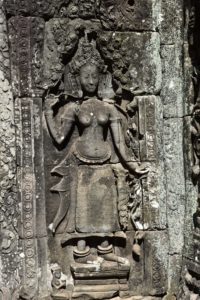The ai r at Angkor Wat is crisp & fragrant. Fragrant with sweet smell of an entity called God. Besides his awe-inspiring physicality, God is present there in every grain of sand every piece of stone every leaf adorning numerous trees and everything living & breathing in & around Angkor. One does not have to make efforts to feel His omniscient presence – the Active Power. Go there and be one with Him.
r at Angkor Wat is crisp & fragrant. Fragrant with sweet smell of an entity called God. Besides his awe-inspiring physicality, God is present there in every grain of sand every piece of stone every leaf adorning numerous trees and everything living & breathing in & around Angkor. One does not have to make efforts to feel His omniscient presence – the Active Power. Go there and be one with Him.
Angkor is not just about the four walls of a temple; so to speak. The story of Angkor will never find its true relevance unles s we are able to take a peek at what comes before the veritable ‘A’ and surely what lies after ‘Z’ in all its completeness. And unless we understand the relationship between man and the cosmic principles and their inexorable linkages with rest of the universe, not limiting it to any religion or belief.
s we are able to take a peek at what comes before the veritable ‘A’ and surely what lies after ‘Z’ in all its completeness. And unless we understand the relationship between man and the cosmic principles and their inexorable linkages with rest of the universe, not limiting it to any religion or belief.
Actions of savages, moss & efflorescence accumulated over centuries, lack of upkeep & maintenance and mercilessness of environmental elements have all left their unerasable blots on everything at Angkor. Joints in stones have opened up, reliefs have been disfigured, stand alone sculptures deliberately marauded a nd edifices reduced to rubble. Let me nevertheless confess – none of these has been able to impair the melancholistic elegance and sacredness of Angkor, one bit. Humanity itself on the other hand seems to have begun to rally around these masterly monuments as if in a massive riposte, by pouring-in in tens of thousands everyday to be one with the Gods and witness these majestic works of those craftsmen who had infused life into the pieces of stone by turning them into Gods by the sheer dint of their toil.
nd edifices reduced to rubble. Let me nevertheless confess – none of these has been able to impair the melancholistic elegance and sacredness of Angkor, one bit. Humanity itself on the other hand seems to have begun to rally around these masterly monuments as if in a massive riposte, by pouring-in in tens of thousands everyday to be one with the Gods and witness these majestic works of those craftsmen who had infused life into the pieces of stone by turning them into Gods by the sheer dint of their toil.
Besides, with hundreds of books written by articulate travellers & histo rians and personal accounts by scores of others whose virtuosity may be none lesser than those more celebrated, I find very little written material relating to the deep religious imprints on the art & architecture of Angkor. Issues such as impact of Buddhism, Vaishnavi & Shaivite traditions, their knowledge of matters engineering, understanding of science of architecture & sculpting, their faith & beliefs in metaphysical knowledge, myths & truths, all need to be revisited afresh in these high technological times to learn more absorbable lessons of life.
rians and personal accounts by scores of others whose virtuosity may be none lesser than those more celebrated, I find very little written material relating to the deep religious imprints on the art & architecture of Angkor. Issues such as impact of Buddhism, Vaishnavi & Shaivite traditions, their knowledge of matters engineering, understanding of science of architecture & sculpting, their faith & beliefs in metaphysical knowledge, myths & truths, all need to be revisited afresh in these high technological times to learn more absorbable lessons of life.
Also, the very scale of operation of this magnitude must have had serious involvement of truly consummate project managers, religious pandits and expert logisticians who must have undertaken this mammoth task over two or even three generations. There appears an urgent need to analyse the contribution of those peoples and work backwards as to their modus operandi. For, there might well lie some superior education for future generations of engineers & architects, in that effort. Who knows?
involvement of truly consummate project managers, religious pandits and expert logisticians who must have undertaken this mammoth task over two or even three generations. There appears an urgent need to analyse the contribution of those peoples and work backwards as to their modus operandi. For, there might well lie some superior education for future generations of engineers & architects, in that effort. Who knows?
Let us explore.